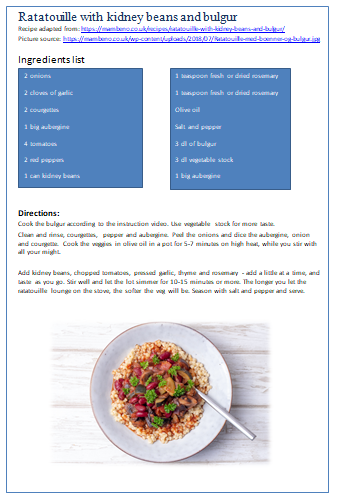In the soon-to-be published Flipped Learning Guide for trainers, you will find a selection of case studies that shows how a Flipped learning course for adults can be designed. One of these is a vegetarian cooking class. It includes hints for course preparation, a course structure with six parts and examples of recipes. Furthermore, suggestions of online educational resources that can be used and a list that connects the course to global elements of effective Flipped Learning are given. Here is a sneak peek of the material, which will soon be available as a printable pdf and eBook.
Description
This case study is an example of a course for adults to teach them how to cook vegetarian meals. It is estimated that around 10 % of Europe’s population are vegetarian or vegan. Becoming vegan or vegetarian is increasingly popular, due to for example concerns for animals, criticism to meat industry and climate change mitigation.
This particular example is designed to teach people basic vegetarian recipes and cooking skills. The course consists of an individually done preparation phase and a training unit done in the group space.
The unit focuses on teaching basic vegetarian cooking skills such as preparation of soyabased products, beans, traditional vegetarian dishes as well as meat-look-alike dishes. The preconditions are basic knowledge of using a kitchen, although an extensive experience with cooking is not needed.
Target group
The target group is adults interested in learning how to cook vegetarian. It is important to note that the participants don’t have to be vegetarian themselves, as many people are interested in learning how to cook for vegetarian members in an household etc. The course can also be adapted to target more specific groups, such as people who want to become vegetarian, elderly men living alone or any other group.
Intended competences
The learner can prepare ingredients that are typical components in vegetarian dishes, such as rice, kidney beans, chickpeas, red and green lentils, soya granules and tofu. In addition, the learner knows some vegetarian recipes, such as chili sin carne, beans and rice, veggie burgers, ratatouille with bulgur. The learner also understands how to make a wholesome and nutritious vegetarian meal with focus on proteins. At the end of the course, the learner should be able to improvise meals around basic recipes.
Technical Issues
The unit uses interactive multimedia-based tools, such as interactive videos, quizzes and collaborative online cookbooks. We suggest a number of free software, but we advice using only 1 or 2 that covers the need of the course in order to not make the participants confused with a large number of possibly new technical software.
Example of a recipe

Some key aspects that distinguishes Flipped Learning from traditional adult education
- Backwards design: the expected outcomes are used as a starting point in the course development.
- No lecturing: when learners come to the cooking class, they already know what to cook, what are ingredients will be used and how they should be prepared. Now it’s time to experience, experiment and create with the teacher as facilitator!
- Use of interactive multimedia: the learners use interactive videos, online platforms for asking questions and creating a collaborative cookbook. The course takes advantage of the many Open Educational resources that already exist.
- Clear differences between individual space and group space activities: this includes difference competences to be developed and different kinds of tasks.
Read more about this in previous blogpost, or wait for our Guide for trainers for full content!
